What Is BIERv6?
Bit Index Explicit Replication IPv6 encapsulation (BIERv6) is a new multicast technology. With BIERv6, the ingress encapsulates into packet headers a set of nodes to which multicast packets are destined as a BitString before sending the packets to transit nodes. In this way, the transit nodes do not need to establish an MDT for each multicast flow, nor do they need to maintain per-flow states. Instead, the transit nodes replicate and forward packets based on the BitString. Combining Bit Index Explicit Replication (BIER) with native IPv6 packet forwarding, BIERv6 can efficiently carry multicast services such as IPTV, video conferencing, remote education, telemedicine, and online live telecasting.
Why Do We Need BIERv6?
Limitations of Conventional Multicast Technologies
Video traffic accounts for a large proportion of Internet traffic and is comprised of services such as video calls, video sharing, and video conferences. High Definition (HD) visual and new interactive videos may become the main form of social interaction in the future, and media will gradually evolve to Virtual Reality (VR) and Augmented Reality (AR). Multicast implements P2MP data forwarding. It effectively reduces redundant traffic on the network as well as reducing the network load. In addition, it reduces the load of the server and CPU in the application platform as well as the impact of the increase of users on the multicast source. With these characteristics, multicast has unique benefits in scenarios such as video streaming, online education, video conferencing, and HD video scenarios.
Conventional multicast solutions include the Global Table Multicast (GTM) solution, IP multicast VPN solution, and MPLS multicast VPN solution. However, these solutions have the following limitations, which hinder the large-scale application of multicast in the preceding scenarios.
- Complex protocols and poor scalability
Transit nodes maintain per-flow multicast states and use multicast routing protocols (such as PIM, mLDP, and RSVP-TE P2MP) to create MDTs, requiring complex control signaling on the network. In addition, creating MDTs consumes a large number of resources, such as memory and CPU resources, hindering large-scale network deployment.
- Low reliability and poor user experience
The more multicast traffic is, the more MDTs need to be established on the network, and the higher the network overhead is. Because post-fault convergence is subject to the number of multicast states, the time required by service re-convergence is prolonged. This severely deteriorates user experience for services that require low latency and fast convergence.
- Difficult deployment and O&M
The network needs to support various protocols, such as PIM, mLDP, and RSVP-TE P2MP. As such, network and service deployment and O&M are complex.
BIER
To overcome the limitations of conventional multicast technologies, a new multicast technology called BIER is proposed in the industry. With BIER, the ingress encapsulates into packets headers a set of nodes to which multicast packets are destined as a BitString before sending the packets to transit nodes. The transit nodes are unaware of multicast group states and only replicate and forward the multicast packets according to the BitString.
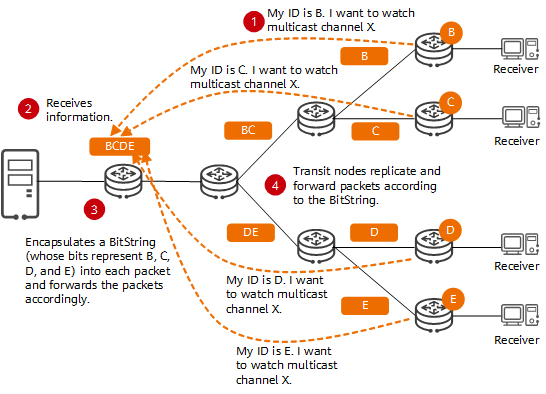
BIER implementation
A network domain that supports BIER forwarding is called a BIER domain, and a router that supports BIER forwarding in such a domain is called a Bit Forwarding Router (BFR). In a BIER domain, BFRs are also called Bit Forwarding Ingress Routers (BFIRs) or Bit Forwarding Egress Routers (BFERs) when they function as ingress or egress routers, respectively. In a BIER domain, a BFIR is a source node, whereas a BFER is a destination node. BFIRs and BFERs are collectively referred to as edge BFRs. Each edge BFR has a dedicated BFR-ID, which is an integer ranging from 1 to 65535. BFR-IDs of destination nodes form a BitString, which represents a destination node set. The position or index of each bit in the BitString indicates a destination node. For example, on a network with 256 edge nodes, each of these nodes needs to be configured with a unique value from 1 to 256. In this case, a 256-bit (32-byte) BitString represents the set of destination nodes. The devices in the BIER domain replicate and forward multicast packets to specified receivers according to the BitString in the packets.
Unlike conventional multicast, which requires a protocol such as PIM for establishing MDTs, BIER does not. On a network running BIER, transit nodes, which do not have multicast services, do not need to establish an MDT for each multicast flow. This eliminates associated overheads, facilitates deployment and O&M, and ensures high network reliability.
Despite its advantages, BIER also has limitations. First, BIER depends on MPLS and is therefore applicable to MPLS networks. This means that, if some multicast services are deployed based on non-MPLS networks or technologies, deploying BIER-MPLS on such a network requires the upgrade of all devices on the network. Second, configuring BIER-MPLS on MPLS multicast VPN networks to advertise BIER information and establish Bit Index Forwarding Tables (BIFTs) across ASs is particularly difficult.
From BIER to BIERv6
In terms of unicast forwarding, SRv6, which is based on the IPv6 data plane, develops rapidly. In terms of multicast, to implement new technologies that are independent of MPLS and match the development trend of IPv6 networks, BIERv6 is proposed in the industry.
BIERv6 inherits the core design concept of BIER. It uses the BitString to guide multicast packet replication and forwarding to specified receivers, eliminates the need for transit nodes to establish MDTs, thereby implementing stateless forwarding. The main difference between BIERv6 and BIER is that BIERv6 is a multicast solution based on native IPv6 rather than MPLS labels.

Comparison between BIER and BIERv6 encapsulation formats
The following figure lists the differences between BIERv6 and BIER in terms of items such as basic forwarding, access control for basic forwarding, multi-hop forwarding, access control for multi-hop forwarding, and whether VPN labels are carried.

Comparison between BIERv6 and BIER
Technical Benefits of BIERv6
BIERv6 simplifies protocols and network deployment, thereby better coping with the challenges of future network development. The technical benefits of BIERv6 are summarized as follows:
- Simplified network protocols
BIERv6 uses IPv6 addresses to carry MVPN and GTM services, further simplifying protocols and eliminating the need to allocate, manage, and maintain MPLS labels. With BIERv6, the ingress encapsulates the set of destination nodes as a BitString into the packet header before forwarding a packet. After receiving the packet, a transit node forwards it to the next node based on the address information contained in the packet header, without needing to create or manage complex protocol or tunnel entries. When a destination node of a service changes, BIERv6 can update the BitString to implement flexible control.
- Simplified deployment and O&M
BIERv6 uses an IPv6 extension header to carry BIER forwarding instructions, eliminating the need for MPLS label-based forwarding. Because services are deployed only on the ingress and egresses, transit nodes are unaware of multicast service changes. When the network topology changes, there is no need to withdraw or re-establish numerous MDTs, thereby greatly simplifying O&M.
- High network reliability
BIERv6 uses IGP extension to flood BIER information, using which each node establishes a multicast forwarding table for data forwarding. In addition, BIERv6 uses unicast routes to forward traffic, meaning that there is no need to establish MDTs. This eliminates the need for complex protocol processing, such as multicast source sharing and SPT switching. If a fault occurs on the network, devices only need to update entries in their BIFTs after convergence of the underlay routes. This ensures fast BIERv6 convergence if a fault occurs, thereby improving reliability and enhancing user experience.
How Is BIERv6 Implemented?
IPv6 Packet Extension
BIERv6 uses IPv6 extension headers to implement its functions. The destination address (End.BIER address) in an IPv6 packet identifies the IPv6 address of a BIER forwarding node and instructs this node to perform BIERv6 forwarding processing. The source address in an IPv6 packet identifies the source of the BIERv6 packet and indicates the multicast VPN instance to which the multicast packet belongs. BIERv6 uses the IPv6 Destination Options Header (DOH) to carry the standard BIER header, which together with the IPv6 header forms the BIERv6 packet header. BFRs read and update the BitString in the BIERv6 extension header and replicate and forward packets according to their BIFTs.

BIERv6 packet header format
The following describes the key fields in the BIERv6 DOH:
- Option Length: indicates the ID of the BIFT.
- TTL: indicates the maximum number of hops through which a packet can be forwarded using BIERv6. The TTL value decrements by 1 each time the packet passes through a BIERv6 forwarding node. When the TTL becomes 0, the packet is discarded.
- Ver: indicates the BIERv6 packet format version.
- BSL: indicates the BitString length. The values 0001, 0010, and 0011 indicate that the BSL is 64-, 128-, and 256-bits long, respectively. One or more BSLs can be configured in a BIERv6 sub-domain.
- Proto: indicates the protocol type of the payload following the BIERv6 packet header. The payload type is defined by the Internet Assigned Numbers Authority (IANA).
- BFIR-ID: This field is set to 0 during packet encapsulation and is ignored when the packet is received. This field can be considered as a reserved field.
- BitString: indicates the set of destination nodes of a multicast packet.
End.BIER
An End.BIER SID is a new type of SID defined for BIERv6. It can be used as an IPv6 destination address to instruct the forwarding plane to process the BIERv6 extension header in a packet. When processing a received BIERv6 packet, each BIERv6 forwarding node encapsulates the End.BIER SID of the next-hop node as the outer IPv6 destination address of the BIERv6 packet (note that the destination nodes of the multicast packet are defined through the BitString). Upon receiving the BIERv6 packet, the next-hop node forwards it according to the BIERv6 process. The End.BIER SID can also fully utilize IPv6 unicast route reachability to allow services to be transmitted across the network, even if some IPv6 nodes do not support BIERv6.
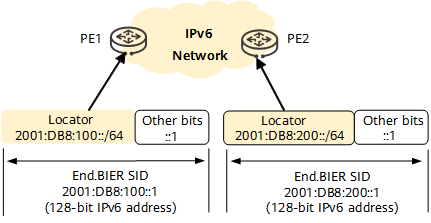
Format of End.BIER in BIERv6
An End.BIER SID consists of two parts: Locator and other bits. A locator indicates a BIERv6 forwarding node and provides the location function. After a locator is configured for a node, a locator route is generated and then propagated throughout the SRv6 domain using an IGP, allowing other nodes to locate this node based on the received locator route. The End.BIER SID directs packets to the specified BFR. After receiving a multicast packet, the BFR identifies that the packet's destination address is a local End.BIER SID and forwards the packet according to the BIERv6 process.
Routing Protocol Extension
IGP Extension
BIERv6 uses IGP extension to flood BIER information, using which each node establishes a multicast forwarding table for data forwarding. Based on the existing IGP for BIER, the IGP extension for BIERv6 uses a sub-sub-TLV to carry BIERv6 encapsulation information and another sub-sub-TLV to flood End.BIER information. Currently, IS-IS has protocol extensions defined for BIERv6.
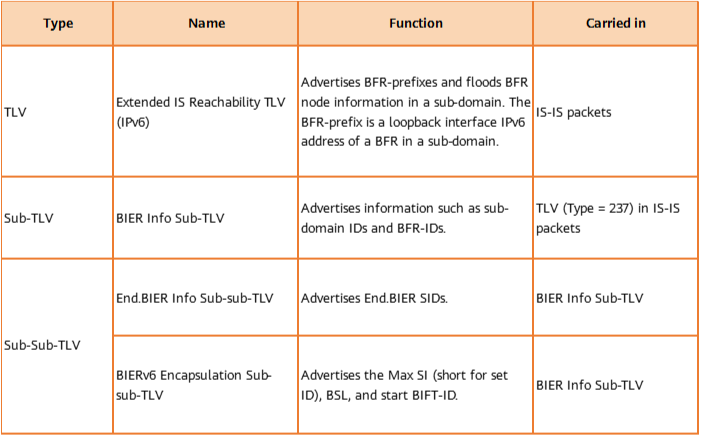
IS-IS extensions for BIERv6
BGP Extension
BIERv6 can carry MVPN services. MVPN over BIERv6 control messages are carried in the NLRI field of BGP Update messages. The Route Type field in the NLRI field indicates the BGP MVPN route type.
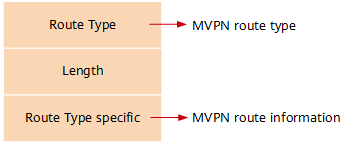
MVPN NLRI format
BIERv6 extends BGP MVPN Inclusive-Provider Multicast Service Interface (I-PMSI) or Selective-Provider Multicast Service Interface (S-PMSI) A-D routes to use their BGP Prefix-SID attribute to carry an MVPN instance's source IPv6 address (Src.DTx), which is an IPv6 address configured on the ingress of a BIER domain for BIERv6 packet forwarding.
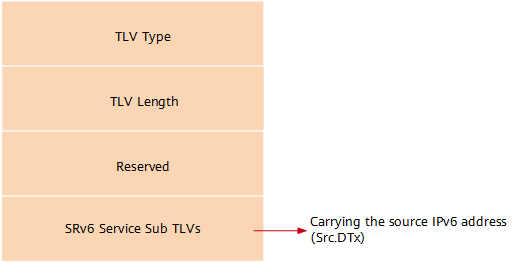
Prefix-SID attribute format
BIERv6 Application in an IPTV Scenario
As the next-generation multicast technology, BIERv6 can be applied to multiple scenarios, such as IPTV scenarios. As shown in the following figure, MVPN over BIERv6 is deployed on the carrier's IP backbone network to carry IPTV traffic, PIM or BIERv6 inter-AS static traversal is deployed on the IP metro network, and PIM is deployed in the VPN where the IPTV video source resides. After receiving a multicast packet from the VPN where the multicast source resides, the sender PE selects a PMSI tunnel based on the information contained in the packet's C-IP header. This PE then inserts the outer BIERv6 packet header (including a set ID and BitString) into the packet based on the tunnel attribute, and sets the outer source IPv6 address. After the preceding operations are complete, the sender PE forwards the multicast packet to the next-hop node according to the BIERv6 forwarding process.
If MVPN over BIERv6 is used to carry IPTV traffic, in addition to reducing the network load and improving user experience (for example, delivering faster VOD, clearer images, and smoother playback), BIERv6 multicast technology simplifies deployment, O&M, and capacity expansion. This makes BIERv6 an ideal choice for large-scale deployment.
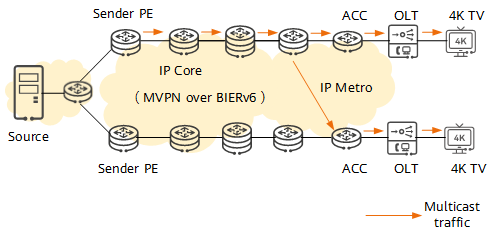
BIERv6 application in an IPTV scenario
- Author: Chen Li
- Updated on: 2021-11-04
- Views: 5807
- Average rating:







